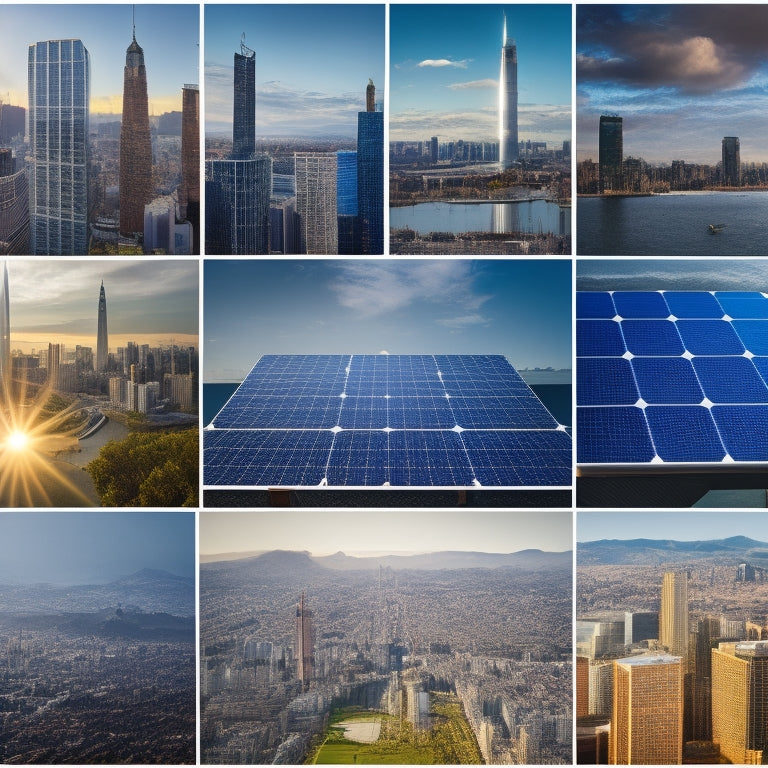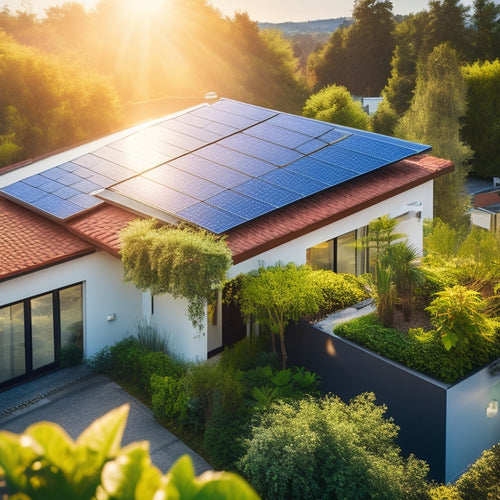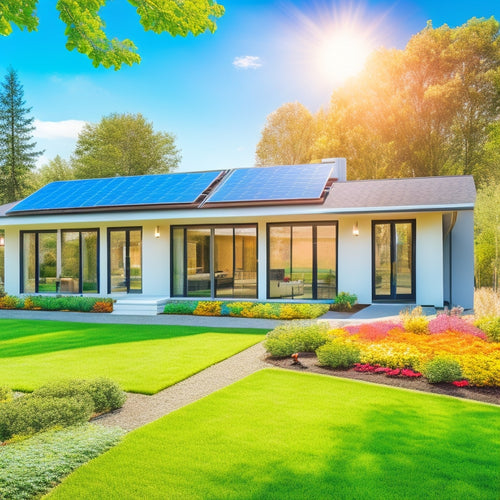
Different Brands of Solar Panels for Renewable Energy
Share
When it comes to utilizing renewable energy, you have a wide range of solar panel brands to choose from, each offering distinct advantages regarding performance, durability, and cost-effectiveness. Top brands like Tesla, Panasonic, and SunPower are known for their high-performance solar panels, with criteria for selection including high-efficiency panels, durable materials, customer reviews, power output, and certifications. You'll also find emerging technologies like bifacial solar cells, which can increase energy output by up to 25%, and perovskite solar cells, which boast higher efficiency rates and lower manufacturing costs. As you investigate your options, you'll reveal more about the latest innovations and how they can help you achieve your renewable energy goals.
Key Takeaways
- Leading solar panel brands like Tesla, Panasonic, and SunPower offer high-performance panels with high-efficiency rates and durable materials.
- Monocrystalline cells provide higher efficiency compared to polycrystalline cells, making them a popular choice for renewable energy.
- Bifacial solar cells capture energy from both sides, increasing energy output by up to 25% and offering improved durability and aesthetics.
- Emerging technologies like perovskite solar cells promise higher efficiency rates and lower manufacturing costs, enhancing the appeal of renewable energy.
- When selecting a solar panel brand, consider factors like certifications, customer reviews, power output, and warranties to ensure a reliable and efficient system.
Top Solar Panel Brands
Innovation has propelled the solar industry forward, and top solar panel brands are leading the charge towards a sustainable future.
You're likely considering investing in solar energy, and choosing the right brand is essential. Look for brands with high-efficiency panels, durable materials, and excellent customer reviews.
Top brands like Tesla, Panasonic, and SunPower offer high-performance panels with impressive warranties. When researching, pay attention to the type of cells used, as monocrystalline cells tend to be more efficient than polycrystalline cells.
You should also consider the power output, temperature coefficient, and certifications like UL and IEC. Before making a purchase, read customer reviews to get a sense of the brand's reliability and customer service.
Additionally, seek installation tips from certified professionals to guarantee a seamless installation process. By doing your due diligence, you'll be well on your way to utilizing renewable energy and reducing your carbon footprint.
Budget-Friendly Solar Options
Several budget-friendly solar options are available for homeowners and businesses looking to employ renewable energy without breaking the bank. You can evaluate affordable installation options that fit your budget, without compromising on quality.
Financing options are also available, making it easier to switch to solar energy. Additionally, government incentives can help reduce the upfront cost of installation. With solar panels, you'll enjoy significant energy savings over time, which can help offset the initial investment.
When choosing a budget-friendly solar option, look for manufacturers that offer long-term durability and thorough warranties. Compare performance guarantees and user reviews to ascertain you're getting a reliable product.
Don't forget to assess the environmental impact of your choice and the potential maintenance costs. By doing your research, you can find a budget-friendly solar option that meets your energy needs while being gentle on your wallet.
High-Efficiency Solar Panels
Efficiency is the name of the game when it comes to utilizing renewable energy from the sun. If you're looking to maximize your energy output, high-efficiency solar panels are the way to go. These panels boast higher power ratings and conversion rates, allowing you to generate more electricity from the same amount of sunlight.
When making solar panel comparisons, you'll notice that high-efficiency models often feature advanced technologies like bifacial cells, multi-busbar designs, and half-cut cells. These innovations enable the panels to capture more photons and reduce energy losses. As a result, you can expect higher wattage outputs and increased energy yields.
Efficiency advancements have also led to more compact and durable designs. This means you can fit more power into a smaller space, making high-efficiency solar panels ideal for rooftops with limited area.
With the latest high-efficiency solar panels, you can access more power and take your renewable energy game to the next level.
Residential Solar Panel Systems
You've optimized your solar panel setup with high-efficiency models, but now it's time to think about the bigger image - your entire residential solar panel system. This involves considering the installation, maintenance, and overall performance of your system.
| Installation Considerations | Maintenance Tips |
|---|---|
| Assess your roof's size and orientation | Schedule regular cleaning |
| Determine the ideal panel angle and tilt | Monitor energy output |
| Choose a compatible inverter and mounting system | Perform routine inspections |
| Consider energy storage options | Check for signs of wear and tear |
| Guarantee compliance with local building codes | Keep records of maintenance and repairs |
When designing your residential solar panel system, it's vital to think about the long-term implications. You'll want to guarantee that your system is installed correctly, with the right components and configuration, to maximize energy production. Additionally, regular maintenance is essential to prevent issues and prolong the lifespan of your system. By following these installation considerations and maintenance tips, you'll be well on your way to utilizing the full power of solar energy for your home.
Commercial Solar Panel Solutions
When you're exploring commercial solar panel solutions, you'll encounter various system design options to suit your business's unique energy needs.
You'll want to take into account factors like roof size, energy usage patterns, and local building codes to determine the best system configuration.
Additionally, you'll need to evaluate panel efficiency ratings to guarantee you're getting the most energy output from your investment.
System Design Options
Several commercial solar panel solutions are available to suit various business needs, each with its unique system design options.
You'll need to evaluate factors like roof size, energy requirements, and existing infrastructure when selecting a system. For instance, you may opt for a rooftop installation or a ground-mounted system, depending on your available space and energy demands.
When integrating your solar system, you'll need to guarantee seamless solar system integration with your existing electrical infrastructure. This may involve upgrading your electrical panel or installing a new one.
Additionally, you may want to assess energy storage solutions to store excess energy generated during the day for use during periods of low sunlight or at night. This can help you maximize your energy independence and reduce your reliance on the grid.
Your system design should also take into account local building codes, permits, and regulations. It's crucial to work with a reputable installer who can guide you through the process and guarantee a smooth, hassle-free installation.
Panel Efficiency Ratings
Among the key considerations for commercial solar panel solutions is panel efficiency ratings, which markedly impact the overall energy output of your system. You want to maximize energy production, and efficiency ratings play a vital role in achieving that goal. Efficiency ratings are usually expressed as a percentage, indicating how much of the sun's energy is converted into electricity.
When comparing panel efficiency, you'll notice that higher-efficiency panels typically produce more power per unit area. This means you may require fewer panels to meet your energy needs, which can lead to cost savings on installation and maintenance.
An efficiency comparison between different brands will help you identify the best option for your commercial solar panel solution. Look for panels with high efficiency ratings, as they'll provide better panel performance and a higher return on investment.
Keep in mind that while high-efficiency panels may come at a higher upfront cost, they can provide long-term benefits and increased energy production.
Emerging Solar Panel Technologies
You're likely familiar with traditional solar panels, but emerging solar panel technologies are taking efficiency to the next level.
Bifacial solar cells, which can capture energy from both sides of the panel, are increasing energy output by up to 25%.
Meanwhile, perovskite solar cells are being investigated for their potential to surpass traditional silicon-based cells regarding power conversion efficiency.
Bifacial Solar Cells
Bifacial solar cells, a novel innovation in photovoltaic technology, have been gaining traction in recent years. You're likely wondering what sets them apart from traditional solar cells. The answer lies in their ability to capture energy from both the front and back sides of the panel. This unique design feature allows bifacial solar cells to increase energy output by up to 25%, making them an attractive option for renewable energy applications.
| Bifacial Advantages | Bifacial Applications | Description |
|---|---|---|
| Increased Energy Output | Residential Rooftops | Higher energy yield from same surface area |
| Improved Durability | Commercial Buildings | Enhanced UV resistance and thermal stability |
| Aesthetically Pleasing | Landfills and Brownfields | Sleek design and reduced visual impact |
| Reduced Land Use | Agricultural Lands | Higher power density, less land required |
| Enhanced Sustainability | Remote Communities | Environmentally friendly and reliable energy source |
As you consider incorporating bifacial solar cells into your renewable energy setup, keep in mind the various advantages and applications they offer. From increased energy output to improved durability, bifacial solar cells are ready to transform the manner in which we capture solar power.
Perovskite Solar Cells
As researchers continue to expand the limits of solar panel technology, perovskite solar cells have emerged as a promising innovation. You're likely curious about what makes them so special. For starters, perovskite solar cells boast higher power conversion efficiency rates than traditional silicon-based cells. This means they can generate more electricity from the same amount of sunlight.
Some of the key benefits and features of perovskite solar cells include:
-
Higher efficiency rates: Perovskite solar cells have shown efficiency rates of over 25%, outperforming traditional silicon-based cells.
-
Lower manufacturing costs: Perovskite materials are cheaper to produce than silicon, making them a more cost-effective option.
-
Flexibility and versatility: Perovskite solar cells can be used in a variety of applications, from building-integrated photovoltaics to wearable electronics.
- Rapid innovation: Researchers are continuously improving perovskite stability, efficiency, and manufacturing processes, clearing the path for widespread adoption in the perovskite market.
While perovskite solar cells face challenges such as stability and scalability, their advantages and innovations make them an exciting development in the field of renewable energy.
Frequently Asked Questions
Can I Install Solar Panels on a Metal or Tile Roof?
You'll need to evaluate installation factors and roof compatibility before putting solar panels on a metal or tile roof; verify the roof's structural integrity, assess potential obstructions, and choose a compatible mounting system for a successful installation.
Do Solar Panels Work During Power Outages?
You'll be glad to know that, during power outages, your solar panels can still generate electricity, offering grid independence, but their efficiency depends on the type of inverter and battery backup system you've installed to store excess energy.
How Often Should I Clean My Solar Panels?
Riding into the future like a 19th-century cowboy on a solar-powered horse, you'll need to clean those panels regularly! Aim to inspect and clean your solar panels every 6-12 months, using gentle cleaning techniques to guarantee ideal solar panel maintenance.
Can I Use Solar Panels for Heating My Pool?
You can use solar panels for heating your pool, increasing pool efficiency by 10-20% with solar heating, which extends the swimming season and reduces energy costs, making it a cost-effective and eco-friendly solution.
Are Solar Panels Resistant to Hail and Extreme Weather?
You're wondering if solar panels can withstand harsh weather. Yes, they're designed to resist hail damage and extreme conditions, with most panels meeting IEC 61215 standards for withstanding 25mm hailstones at 23m/s and extreme temperatures.
Conclusion
As you weigh your solar panel options, remember that the best brand for you depends on your unique needs and budget. Are you willing to invest in high-efficiency panels for maximum energy output, or do you prioritize affordability? With so many reputable brands and emerging technologies on the market, you're spoiled for choice. Ultimately, which brand will you choose to utilize the power of the sun and reduce your carbon footprint?
Related Posts
-

Solar Power Systems for Cost-Effective Sustainability
Investing in solar power systems is a smart move for cost-effective sustainability. You can save about $1,500 annuall...
-

How Solar Panels Increase Property Value
Installing solar panels considerably increases your property value by improving energy efficiency and attracting eco-...
-

Solar Power Advantages for Rural Communities
Solar power presents numerous advantages for rural communities. You can greatly reduce energy costs, potentially by u...


